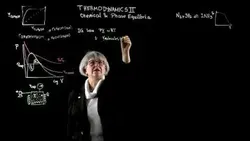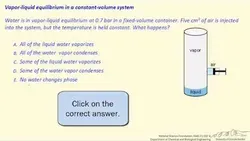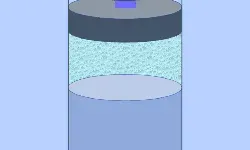
THERMODYNAMICS II - ProfDr Deniz uner

This course covers the fundamentals of chemical and phase equilibria, stability and equilibrium, fugacity of pure liquids and solids, and thermodynamics of multicomponent mixtures. It also explores the Gibbs energy and fugacity of mixtures. Professor Deniz Üner provides an in-depth look at these topics, helping students gain a better understanding of thermodynamics.▼
Course Feature
![]() Cost:
Cost:
Free
![]() Provider:
Provider:
Youtube
![]() Certificate:
Certificate:
Paid Certification
![]() Language:
Language:
English
![]() Start Date:
Start Date:
On-Demand
Course Overview
❗The content presented here is sourced directly from Youtube platform. For comprehensive course details, including enrollment information, simply click on the 'Go to class' link on our website.
Updated in [February 21st, 2023]
Learners can learn a variety of topics from Thermodynamics II, including chemical and phase equilibria, stability and equilibrium, fugacity of pure liquids and solids, thermodynamics of multicomponent mixtures I and II, Gibbs energy and fugacity of components in a mixture, MATLAB2, thermodynamics of mixtures, excess GFE and its relation to activity coefficient, and chemical reaction equilibrium. This course provides a comprehensive overview of the principles of thermodynamics and their application to real-world problems. Learners will gain a deep understanding of the concepts and be able to apply them to solve complex problems. They will also learn how to use MATLAB2 to analyze and visualize data. Finally, they will gain an understanding of the relationship between thermodynamics and chemical reaction equilibrium. This course is an invaluable resource for anyone looking to gain a deeper understanding of thermodynamics and its applications.
[Applications]
Upon completion of this course, students should be able to apply the concepts of thermodynamics to analyze and solve problems related to chemical and phase equilibria, stability and equilibrium, fugacity of pure liquids and solids, thermodynamics of multicomponent mixtures, Gibbs energy and fugacity of components in a mixture, thermodynamics of mixtures, excess GFE and its relation to activity coefficient, and chemical reaction equilibrium. Additionally, students should be able to use MATLAB2 to solve thermodynamic problems.
[Career Paths]
1. Chemical Engineer: Chemical engineers use thermodynamics to design and develop processes and products in the chemical, pharmaceutical, and energy industries. They use their knowledge of thermodynamics to optimize the efficiency of production processes, develop new products, and improve existing products. As the demand for energy and new products increases, the need for chemical engineers with thermodynamics expertise is expected to grow.
2. Process Engineer: Process engineers use thermodynamics to design and optimize industrial processes. They use their knowledge of thermodynamics to develop efficient processes for the production of chemicals, pharmaceuticals, and energy. Process engineers are also responsible for troubleshooting existing processes and ensuring that they are operating safely and efficiently.
3. Energy Engineer: Energy engineers use thermodynamics to design and optimize energy systems. They use their knowledge of thermodynamics to develop efficient energy systems for the production of electricity, heat, and cooling. Energy engineers are also responsible for troubleshooting existing energy systems and ensuring that they are operating safely and efficiently.
4. Environmental Engineer: Environmental engineers use thermodynamics to design and optimize environmental systems. They use their knowledge of thermodynamics to develop efficient environmental systems for the production of clean air, water, and soil. Environmental engineers are also responsible for troubleshooting existing environmental systems and ensuring that they are operating safely and efficiently.
[Education Paths]
1. Chemical Engineering: Chemical engineering is a field of engineering that focuses on the design and operation of chemical processes. It combines the principles of chemistry, physics, mathematics, and economics to develop efficient and cost-effective solutions to problems in the production, processing, and use of chemicals and materials. Chemical engineering is a rapidly growing field, with new developments in areas such as nanotechnology, biotechnology, and green chemistry.
2. Materials Science and Engineering: Materials science and engineering is a field of engineering that focuses on the study of materials and their properties. It combines the principles of chemistry, physics, and engineering to develop new materials and technologies for a variety of applications. This field is rapidly growing, with new developments in areas such as nanotechnology, biotechnology, and green chemistry.
3. Biochemical Engineering: Biochemical engineering is a field of engineering that focuses on the design and operation of biochemical processes. It combines the principles of biology, chemistry, physics, and engineering to develop efficient and cost-effective solutions to problems in the production, processing, and use of biological materials. This field is rapidly growing, with new developments in areas such as bioprocessing, bioremediation, and biotechnology.
4. Environmental Engineering: Environmental engineering is a field of engineering that focuses on the design and operation of systems to protect and improve the environment. It combines the principles of biology, chemistry, physics, and engineering to develop efficient and cost-effective solutions to problems in the production, processing, and use of natural resources. This field is rapidly growing, with new developments in areas such as green chemistry, renewable energy, and sustainable development.
Course Provider






